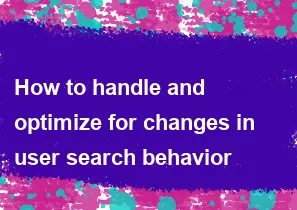How to handle and optimize for changes in user search behavior

Handling and optimizing for changes in user search behavior is crucial for maintaining the relevance and effectiveness of your website, application, or platform. User search behavior can evolve due to various factors such as technological advancements, societal changes, or even external events like a global pandemic. Here are some strategies to help you adapt and optimize for changes in user search behavior:
Regularly Analyze User Data:
- Use analytics tools to monitor and analyze user search data regularly. Look for patterns, trends, and changes in user behavior.
- Pay attention to popular search queries, click-through rates, and the performance of specific content or products.
Stay Informed About Industry Trends:
- Stay updated on industry trends, technological advancements, and changes in user preferences. Follow relevant publications, attend conferences, and participate in online forums to stay informed.
Implement Machine Learning and AI:
- Utilize machine learning and AI algorithms to improve the accuracy and relevance of search results. These technologies can adapt to changing user behavior over time and provide more personalized recommendations.
Optimize Content:
- Regularly update and optimize your content based on changing user interests and search queries.
- Conduct keyword research to identify new relevant keywords and phrases that reflect current user preferences.
Enhance User Experience:
- Focus on improving the overall user experience of your platform. A user-friendly interface and intuitive search functionality can positively impact user satisfaction.
- Implement features such as autocomplete and suggestions to assist users in refining their searches.
Mobile Optimization:
- Optimize your platform for mobile devices, as mobile search behavior may differ from desktop behavior. Ensure that your website or app is responsive and provides a seamless experience on various devices.
Adapt to Voice Search:
- With the increasing popularity of voice-activated devices and voice search, optimize your content for natural language queries.
- Consider the conversational tone and long-tail keywords that users might use in voice searches.
Implement A/B Testing:
- Conduct A/B testing on your search algorithms, user interface, and content presentation. This helps you understand how changes affect user engagement and conversion rates.
User Feedback and Surveys:
- Collect feedback from users through surveys, interviews, and feedback forms. Understand their needs, preferences, and any challenges they face during the search process.
Agile Development Approach:
- Adopt an agile development approach to quickly respond to changes in user behavior. This allows you to iterate and make improvements based on real-time data.
Collaborate Across Teams:
- Foster collaboration between your development, marketing, and customer support teams. Insights from different perspectives can help in creating a holistic strategy for adapting to changes in user search behavior.
Remember that optimizing for changes in user search behavior is an ongoing process. Regularly monitor metrics, stay informed about industry developments, and be agile in implementing changes to ensure your platform remains relevant and user-friendly.
-
Popular Post
- How to optimize for Google's About This Result feature for local businesses
- How to implement multi-language support in an Express.js application
- How to handle and optimize for changes in mobile search behavior
- How to handle CORS in a Node.js application
- How to use Vue.js with a UI framework (e.g., Vuetify, Element UI)
- How to configure Laravel Telescope for monitoring and profiling API requests
- How to create a command-line tool using the Commander.js library in Node.js
- How to implement code splitting in a React.js application
- How to use the AWS SDK for Node.js to interact with various AWS services
- How to use the Node.js Stream API for efficient data processing
- How to implement a cookie parser middleware in Node.js
- How to implement WebSockets for real-time communication in React
-
Latest Post
- How to implement a dynamic form with dynamic field styling based on user input in Next.js
- How to create a custom hook for handling user interactions with the browser's device motion in Next.js
- How to create a custom hook for handling user interactions with the browser's battery status in Next.js
- How to implement a dynamic form with dynamic field visibility based on user input in Next.js
- How to implement a dynamic form with real-time collaboration features in Next.js
- How to create a custom hook for handling user interactions with the browser's media devices in Next.js
- How to use the useSWRInfinite hook for paginating data with a custom loading indicator in Next.js
- How to create a custom hook for handling user interactions with the browser's network status in Next.js
- How to create a custom hook for handling user interactions with the browser's location in Next.js
- How to implement a dynamic form with multi-language support in Next.js
- How to create a custom hook for handling user interactions with the browser's ambient light sensor in Next.js
- How to use the useHover hook for creating interactive image zoom effects in Next.js